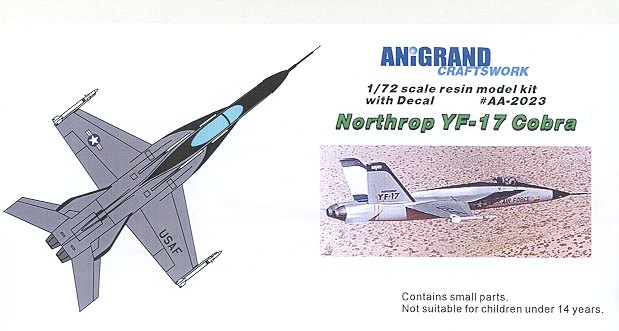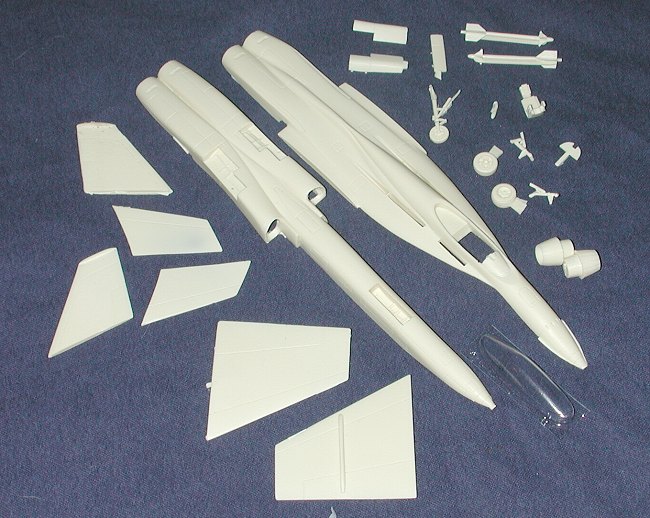
| KIT: | Anigrand Model Works 1/72 YF-17 Cobra |
| KIT #: | AA-2023 |
| PRICE: | $58.00 MSRP |
| DECALS: | One option |
| REVIEWER: | Scott Van Aken |
| NOTES: | Resin kit with vac canopy |

| HISTORY |
In the late 1960s, it was obvious that the USAF was going to need a new fighter. It had already opted for the F-15 as a fighter/interceptor to replace the F-4 and F-106 that were operating in that role. It had the A-9/A-10 fly-off to determine a new dedicated ground attack aircraft to replace the A-7, but it needed another fighter. Because of the huge cost of the F-15, building more Eagles wasn't really an option. What was needed was a smaller, lightweight fighter to supplement the F-15. Besides, the USAF was somewhat anxious to get all the Navy designed aircraft out of its front-line inventory. I mean, having to fly Navy designed planes was bad enough but to have had them out-perform purpose USAF designed planes was just too much for some of the brass. They had to have their own.
Two proposals made it passed the interminable review boards and those were General Dynamics' YF-16, a single engine aircraft, and Northrop's YF-17, a twin-engine plane.
The YF-17 first flew in 1974 and became the first US fighter to break the sound barrier without having to go into afterburner to do so. It was fast. It also had the benefit of two engines in case one was damaged or became inoperable. Both aircraft were put through their paces and while they generally performed about the same. However, the YF-16 was a bit faster and had slightly better range. Much of this from being lighter in that it didn't have to carry the additional fuel for the second engine.
Though I'd hate to say that politics had a role in this, Northrop has generally been given the shaft in many of its aviation projects thanks to a years-long animosity with the USAF brass in general. It seems that everything Northrop tried to produce was foiled in some way. One only has to look at the F-5G/F-20 defense fighter to see this problem. Northrop produced a superior aircraft that could be in the air within minutes of engine start. Yet it was hampered by all sorts of strictures on who it could be sold to. The result was total failure to produce what really was a superlative aircraft.
The YF-17, however, did not go away. It was of great interest to the US Navy, who was also looking for a smaller multi-role attack fighter to replace its A-7 fleet. Northrop partnered with McDonnell/Douglas to produce the similar but much larger and heavier F-18. The deal was that Northrop would build the F-18L, a lighter, land based only version and McDonnell/Douglas would do the navalized variant. Needless to say, not a single F-18L was ever built........
| THE KIT |

If you have read any of my previous previews of Anigrand kits then you can pretty well know what to expect. For those who haven't, allow me to recap a bit. The kit is well molded in a buff resin. There are nicely engraved panel lines which are really a touch too deep, but paint will help fill those in a bit. As with all Anigrand kits I've built, this one will require filler. There are some air bubbles in the intakes and I also found some on the top of one of the fins. Much to my delight, I did not see any problems with the smaller pieces. Short run resin kits are a bit of a crap shoot as to how well they will be molded as they are not done on a production line but by hand, one at a time.
This kit has a full cockpit tub with a nicely formed seat, control stick and instrument panel. There is no detail on the instrument panel nor is there a decal for the panel or side consoles. You might be able to rob these items from an old plastic F-18 kit as they are similar. What you can't rob are the landing gear as the ones on the F-18 are completely different. An interesting touch on this kit is that there are stub wing roots on the upper fuselage half for you to match the wings. Makes filling the seam much easier. Like-wise, the missiles are molded with the rails and wing tips. The pressure relief slots in the LEREX are particularly well done and I like that Anigrand has molded the splitter plates into the lower fuselage. Just means less stuff to have to trim and fit. One of the down sides to this particular kit is that there is no intake trunking. You'll need to put some card behind the intakes to prevent seeing into the large, cavernous fuselage cavity! Only one canopy is provided and it still has barely visible framework lines so masking will be tricky.
 Instructions are like all
Anigrand kits, providing basically an exploded diagram of the kit. For a
kit like this, that is quite acceptable as this is not a kit for beginners.
The builder will have to provide the nose tip and probe from stretches
sprue as none is provided. Though one is shown as molded onto the upper
fuselage half, mine didn't have one. Break out the epoxy putty and fine
tubing for this one! Decals are provided for one early prototype in overall
silver paint with black detail work. The decals provide only the standard
markings. The decals are well printed and a bit thick. Experience with
these shows that they stick well to pretty flat surfaces but don't like
compound curves at all. Fortunately, they will not have to tackle anything
but pretty flat areas on this kit. All the trim work will have to be
painted. Those who really want to get adventurous can do the neat
camouflage scheme of several blue/greys that it carried later in its
career.
Instructions are like all
Anigrand kits, providing basically an exploded diagram of the kit. For a
kit like this, that is quite acceptable as this is not a kit for beginners.
The builder will have to provide the nose tip and probe from stretches
sprue as none is provided. Though one is shown as molded onto the upper
fuselage half, mine didn't have one. Break out the epoxy putty and fine
tubing for this one! Decals are provided for one early prototype in overall
silver paint with black detail work. The decals provide only the standard
markings. The decals are well printed and a bit thick. Experience with
these shows that they stick well to pretty flat surfaces but don't like
compound curves at all. Fortunately, they will not have to tackle anything
but pretty flat areas on this kit. All the trim work will have to be
painted. Those who really want to get adventurous can do the neat
camouflage scheme of several blue/greys that it carried later in its
career.
| CONCLUSIONS |
No one can have a really complete US fighters collection without adding the YF-17 to their shelves. Thanks to the relative simplicity of this kit, (at a total of 24 parts, including the canopy, it shouldn't strain anyone's abilities) it would be a good one for someone who is looking to doing their first full resin kit.
| REFERENCES |
My sometimes faulty memory.
Many thanks to DMC Models for the review kit.
UPDATE: Nostalgic Plastic is now the US Importer for Anigrand. Please contact them for more information.
If you would like your product reviewed fairly and fairly quickly by a site that has over 250,000 visitors a month, please contact me or see other details in the Note to Contributors.